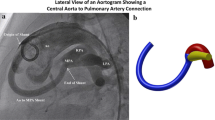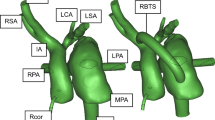Abstract
To examine blood flow after the placement of a Blalock-Taussig shunt, three complex T-figure models were developed according to shunt size and the degree of pulmonary artery hypoplasia. With the use of computational fluid dynamics, the net energy loss and wall shear stress were calculated under pulsatile conditions. We calculated that the 5-mm shunt carried the least energy loss, but the most wall shear stress. In this simulation, the 5-mm shunt was thought to be superior to the 4-mm and 3-mm shunts in terms of energy loss and smooth flow, but it produced high wall shear stress.
Similar content being viewed by others
Author information
Authors and Affiliations
Additional information
Received: September 11, 2000 / Accepted: March 6, 2001
Rights and permissions
About this article
Cite this article
Song, MH., Sato, M. & Ueda, Y. Three-Dimensional Simulation of the Blalock-Taussig Shunt Using Computational Fluid Dynamics. Surg Today 31, 688–694 (2001). https://doi.org/10.1007/s005950170071
Issue Date:
DOI: https://doi.org/10.1007/s005950170071




